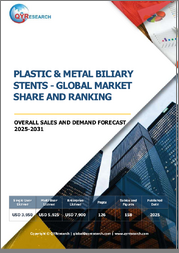
|
시장보고서
상품코드
1622471
스텐트 시장 규모, 점유율, 성장 분석 : 제품별, 소재별, 최종사용자별, 지역별 - 산업 예측(2025-2032년)Stents Market Size, Share, Growth Analysis, By Product (Vascular, Non-Vascular Stents), By Material (Metallic Stents, Non-Metallic Stents), By End User, By Region - Industry Forecast 2025-2032 |
||||||
스텐트 시장 규모는 2023년에 93억 달러로 평가되며, 2024년 96억 1,000만 달러에서 2032년에는 125억 달러로 성장하며, 예측 기간(2025-2032년)의 CAGR은 3.3%로 성장할 전망입니다.
세계의 스텐트 시장은 CDC에 의하면 2019년에 약 360,900명의 사망으로 연결된 관상동맥 질환의 유병률 상승에 의해 촉진되어 큰 성장을 목격하고 있습니다. 이러한 급격한 성장은 스텐트 설계의 기술적 진보, 헬스케어 개발에 대한 민간 및 정부의 투자 증가, 약제용출 스텐트에 대한 수요 증가에 의해 주도되고 있습니다. 막힌 동맥의 혈류를 유지하는 데 필수적인 의료기기인 스텐트는 심혈관 질환뿐만 아니라 대동맥이나 뇌와 같은 중요한 부위의 동맥류 예방에도 활용되고 있습니다. 2021년 8월 시노메드가 유럽에서 출시한 HT Supreme 약물용출 스텐트는 업계의 끊임없는 혁신과 환자 니즈에 대한 대응을 강조하는 대표적인 사례입니다.
목차
서론
- 조사의 목적
- 조사 범위
- 정의
조사 방법
- 정보 조달
- 2차 데이터와 1차 데이터 방법
- 시장 규모 예측
- 시장의 전제조건과 제한
개요
- 세계 시장 전망
- 공급과 수요의 동향 분석
- 부문별 기회 분석
시장 역학과 전망
- 시장 개요
- 시장 규모
- 시장 역학
- 촉진요인과 기회
- 억제요인과 과제
- Porter의 산업 분석
주요 시장 인사이트
- 주요 성공 요인
- 경쟁의 정도
- 주요 투자 기회
- 시장 에코시스템
- 시장의 매력 지수(2024년)
- PESTEL 분석
- 거시경제 지표
- 밸류체인 분석
- 가격 분석
- 기술의 진보
- 무역 분석
스텐트 시장 규모 : 제품별
- 시장 개요
- 혈관
- 관상동맥 스텐트
- 주변 스텐트
- 장골 동맥 스텐트
- 대퇴 동맥 스텐트
- 경동맥 스텐트
- 신장 동맥 스텐트
- 기타 주변 스텐트
- 신경혈관 스텐트
- 두개내 스텐트
- Flow Diverters
- 비혈관계 스텐트
- 위장 스텐트
- 담도
- 십이지장
- 결장
- 췌장
- 식도 스텐트
- 폐(기도) 스텐트
- 실리콘 기도
- 금속 기도
- 비뇨기과 스텐트
- 기타
스텐트 시장 규모 : 소재별
- 시장 개요
- 금속 스텐트
- 비금속 스텐트
스텐트 시장 규모 : 최종사용자별
- 시장 개요
- 병원
- 전문 클리닉
- 외래 수술 센터
- 기타
스텐트 시장 규모
- 북미
- 미국
- 캐나다
- 유럽
- 독일
- 스페인
- 프랑스
- 영국
- 이탈리아
- 기타 유럽 지역
- 아시아태평양
- 중국
- 인도
- 일본
- 한국
- 기타 아시아태평양
- 라틴아메리카
- 브라질
- 기타 라틴아메리카 지역
- 중동 및 아프리카
- GCC 국가
- 남아프리카공화국
- 기타 중동 및 아프리카
경쟁 정보
- 상위 5사의 비교
- 주요 기업의 시장 포지셔닝(2024년)
- 주요 시장 기업이 채택한 전략
- 시장의 최근 동향
- 기업의 시장 점유율 분석(2024년)
- 주요 기업의 기업 개요
- 회사 개요
- 제품 포트폴리오 분석
- 부문별 점유율 분석
- 매출의 전년대비 비교(2022-2024)
주요 기업 개요
- Boston Scientific
- Medtronic
- Abbott Laboratories
- Terumo Corporation
- Johnson & Johnson
- B. Braun Melsungen AG
- BIOTRONIK SE & Co. KG
- Cook Medical
- MicroPort Scientific Corporation
- Sahajanand Medical Technologies
- Alvimedica
- Biosensors International
- Lepu Medical Technology
- Meril Life Sciences
- Balton Sp. z o.o.
- Translumina Therapeutics
- Vascular Concepts
- Relisys Medical Devices
- Endocor GmbH
- Hexacath
결론과 권장사항
KSA 25.01.16Stents Market size was valued at USD 9.3 Billion in 2023 and is poised to grow from USD 9.61 Billion in 2024 to USD 12.5 Billion by 2032, growing at a CAGR of 3.3% during the forecast period (2025-2032).
The global stents market is witnessing significant growth driven by the rising prevalence of coronary artery disease, which led to approximately 360,900 deaths in 2019, according to the CDC. This surge is propelled by technological advancements in stent design, heightened investment from both private and government sources into healthcare development, and an escalating demand for drug-eluting stents. Stents, essential medical devices that maintain blood flow in blocked arteries, are increasingly being utilized not only for cardiovascular diseases but also for preventing aneurysms in critical areas like the aorta and brain. A notable example includes the European launch of the HT Supreme Drug-eluting stent by Sinomed in August 2021, highlighting the industry's continuous innovation and response to patient needs.
Top-down and bottom-up approaches were used to estimate and validate the size of the Stents market and to estimate the size of various other dependent submarkets. The research methodology used to estimate the market size includes the following details: The key players in the market were identified through secondary research, and their market shares in the respective regions were determined through primary and secondary research. This entire procedure includes the study of the annual and financial reports of the top market players and extensive interviews for key insights from industry leaders such as CEOs, VPs, directors, and marketing executives. All percentage shares split, and breakdowns were determined using secondary sources and verified through Primary sources. All possible parameters that affect the markets covered in this research study have been accounted for, viewed in extensive detail, verified through primary research, and analyzed to get the final quantitative and qualitative data.
Stents Market Segmental Analysis
Global Stents Market is segmented by product, material, end user and region. Based on product, the market is segmented into vascular and non-vascular stents. Based on material, the market is segmented into metallic stents and non-metallic stents. Based on end user, the market is segmented into hospitals, specialty clinics, ambulatory surgery centers and others. Based on region, the market is segmented into North America, Europe, Asia Pacific, Latin America and Middle East & Africa.
Driver of the Stents Market
The stent market is significantly driven by the increasing global incidence of cardiovascular diseases (CVDs), which is anticipated to enhance market growth in the coming years. The rise in chronic disease cases is leading to greater demand for procedures such as percutaneous coronary interventions and peripheral vascular surgeries. The World Health Organization (WHO) reports that cardiovascular diseases result in approximately 17.9 million deaths annually, representing around 32% of all global fatalities. As the number of individuals affected by cardiovascular conditions continues to grow, it will inevitably heighten the need for stents, thereby propelling market demand.
Restraints in the Stents Market
One significant restraint on the stents market is the rigorous regulatory environment that hinders its growth potential. Various regulatory agencies, including the FDA, enforce stringent guidelines and requirements for the safe and effective use of stents. The FDA's thorough evaluation process necessitates a careful review of existing literature and pre-clinical animal studies prior to granting approval. This process is often resource-intensive, demanding considerable time and financial investment, particularly as coronary stents are classified as category III devices. Additionally, the classification of stents as medium to high-risk medical devices subjects them to stringent regulatory compliance, ultimately dampening market demand due to the complexity and costs associated with obtaining necessary approvals.
Market Trends of the Stents Market
The stents market is witnessing significant growth driven by continuous innovations and refinements in product design. Key advancements focus on optimizing stent features, such as reducing strut thickness, enhancing deliverability in complex vascular anatomies, and introducing a variety of lengths and diameters. Recent breakthroughs, like the FDA-approved Xience Sierra in 2018, emphasize enhanced flexibility and smaller profiles for improved performance during percutaneous coronary interventions (PCI). These developments aim to enhance patient outcomes and reduce procedural complications, thereby fueling market expansion. As healthcare providers increasingly adopt these advanced stent technologies, the market is poised for robust growth in the coming years.
Table of Contents
Introduction
- Objectives of the Study
- Scope of the Report
- Definitions
Research Methodology
- Information Procurement
- Secondary & Primary Data Methods
- Market Size Estimation
- Market Assumptions & Limitations
Executive Summary
- Global Market Outlook
- Supply & Demand Trend Analysis
- Segmental Opportunity Analysis
Market Dynamics & Outlook
- Market Overview
- Market Size
- Market Dynamics
- Drivers & Opportunities
- Restraints & Challenges
- Porters Analysis
- Competitive rivalry
- Threat of substitute
- Bargaining power of buyers
- Threat of new entrants
- Bargaining power of suppliers
Key Market Insights
- Key Success Factors
- Degree of Competition
- Top Investment Pockets
- Market Ecosystem
- Market Attractiveness Index, 2024
- PESTEL Analysis
- Macro-Economic Indicators
- Value Chain Analysis
- Pricing Analysis
- Technological Advancement
- Trade Analysis
Global Stents Market Size by Product & CAGR (2025-2032)
- Market Overview
- Vascular
- Coronary Stents
- Peripheral Stents
- Iliac Artery Stents
- Femoral Artery Stents
- Carotid Artery Stents
- Renal Artery Stents
- Other Peripheral Stents
- Neurovascular Stents
- Intracranial Stents
- Flow Diverters
- Non-Vascular Stents
- Gastrointestinal Stents
- Biliary
- Duodenal
- Colonic
- Pancreatic
- Esophageal Stents
- Pulmonary (Airway) Stents
- Silicone Airway
- Metallic Airway
- Urological Stents
- Others
Global Stents Market Size by Material & CAGR (2025-2032)
- Market Overview
- Metallic Stents
- Non-Metallic Stents
Global Stents Market Size by End User & CAGR (2025-2032)
- Market Overview
- Hospitals
- Specialty Clinics
- Ambulatory Surgery Centers
- Others
Global Stents Market Size & CAGR (2025-2032)
- North America (Product, Material, End User)
- US
- Canada
- Europe (Product, Material, End User)
- Germany
- Spain
- France
- UK
- Italy
- Rest of Europe
- Asia Pacific (Product, Material, End User)
- China
- India
- Japan
- South Korea
- Rest of Asia-Pacific
- Latin America (Product, Material, End User)
- Brazil
- Rest of Latin America
- Middle East & Africa (Product, Material, End User)
- GCC Countries
- South Africa
- Rest of Middle East & Africa
Competitive Intelligence
- Top 5 Player Comparison
- Market Positioning of Key Players, 2024
- Strategies Adopted by Key Market Players
- Recent Developments in the Market
- Company Market Share Analysis, 2024
- Company Profiles of All Key Players
- Company Details
- Product Portfolio Analysis
- Company's Segmental Share Analysis
- Revenue Y-O-Y Comparison (2022-2024)
Key Company Profiles
- Boston Scientific
- Company Overview
- Business Segment Overview
- Financial Updates
- Key Developments
- Medtronic
- Company Overview
- Business Segment Overview
- Financial Updates
- Key Developments
- Abbott Laboratories
- Company Overview
- Business Segment Overview
- Financial Updates
- Key Developments
- Terumo Corporation
- Company Overview
- Business Segment Overview
- Financial Updates
- Key Developments
- Johnson & Johnson
- Company Overview
- Business Segment Overview
- Financial Updates
- Key Developments
- B. Braun Melsungen AG
- Company Overview
- Business Segment Overview
- Financial Updates
- Key Developments
- BIOTRONIK SE & Co. KG
- Company Overview
- Business Segment Overview
- Financial Updates
- Key Developments
- Cook Medical
- Company Overview
- Business Segment Overview
- Financial Updates
- Key Developments
- MicroPort Scientific Corporation
- Company Overview
- Business Segment Overview
- Financial Updates
- Key Developments
- Sahajanand Medical Technologies
- Company Overview
- Business Segment Overview
- Financial Updates
- Key Developments
- Alvimedica
- Company Overview
- Business Segment Overview
- Financial Updates
- Key Developments
- Biosensors International
- Company Overview
- Business Segment Overview
- Financial Updates
- Key Developments
- Lepu Medical Technology
- Company Overview
- Business Segment Overview
- Financial Updates
- Key Developments
- Meril Life Sciences
- Company Overview
- Business Segment Overview
- Financial Updates
- Key Developments
- Balton Sp. z o.o.
- Company Overview
- Business Segment Overview
- Financial Updates
- Key Developments
- Translumina Therapeutics
- Company Overview
- Business Segment Overview
- Financial Updates
- Key Developments
- Vascular Concepts
- Company Overview
- Business Segment Overview
- Financial Updates
- Key Developments
- Relisys Medical Devices
- Company Overview
- Business Segment Overview
- Financial Updates
- Key Developments
- Endocor GmbH
- Company Overview
- Business Segment Overview
- Financial Updates
- Key Developments
- Hexacath
- Company Overview
- Business Segment Overview
- Financial Updates
- Key Developments



















